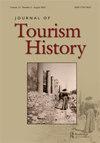Flamboyance and wit. The promotion of film-induced tourism and Andalusian-inspired ‘brand Spain’ under the Ministry of Information and Tourism (1953-1959)
IF 0.9
Q4 HOSPITALITY, LEISURE, SPORT & TOURISM
引用次数: 0
Abstract
ABSTRACT This paper aims to demonstrate that Hollywood film-induced tourism strategies also resonated in Spain in the 1950s, coinciding with the arrival of large contingents of American tourists in historical European cities. The use of these techniques, at a key moment of the diffident opening-up of Franco's regime, was adopted as a new and promising means to diffuse the traditionally Andalusian-inspired brand, combining the wit of Bienvenido Míster Marshall with the flamboyance of Duende y Misterio del Flamenco (both winners at Cannes 1953), and taking as a model pioneering films such as Roman holiday, 1953 and Summertime, 1955. To this end, the promotional strategies of 6 films featuring tourists and shot in Andalusia during the period 1953–1959 are analysed. The results, computerised using NVivo software, suggest, not only the use of wit and flamboyance, but also the display of inductive techniques such as the depiction of an open tourist context, the mobilisation of tourist celebrities (Antonio ‘the dancer’, Pedro de Córdoba, Pastora Imperio, Dolores Vargas or Carmen Sevilla), as well as the portrayal of Spanish culture for foreign tourists in search of authenticity, with characters performed by international players (Geneviève Page, Merle Oberon, Vittorio De Sica or Ludmilla Tchérina).华丽和机智。在信息和旅游部的领导下促进电影诱导旅游和安达卢西亚启发的“品牌西班牙”(1953-1959)
本文旨在证明好莱坞电影引发的旅游策略在20世纪50年代的西班牙也产生了共鸣,与此同时,大批美国游客来到欧洲历史名城。这些技术的使用,在佛朗哥政权缺乏自信的开放的关键时刻,被作为一种新的和有前途的方式来传播传统的安达卢西亚风格的品牌,将Bienvenido Míster Marshall的智慧与Duende y Misterio del Flamenco的华丽(1953年戛纳电影节的获奖者)结合起来,并以1953年的《罗马假日》和1955年的《夏日》等先锋电影为榜样。为此,本文分析了1953-1959年期间在安达卢西亚拍摄的6部以游客为主题的电影的宣传策略。使用NVivo软件计算机化的结果表明,不仅使用机智和华丽,而且还展示了诱导技术,例如描绘开放的旅游环境,动员旅游名人(“舞者”安东尼奥,佩德罗·德Córdoba, Pastora Imperio,多洛雷斯·巴尔加斯或卡门·塞维利亚),以及为寻求真实性的外国游客描绘西班牙文化,由国际演员扮演的角色(genevi Page, Merle Oberon,Vittorio De Sica或Ludmilla tchacriina)。
本文章由计算机程序翻译,如有差异,请以英文原文为准。
求助全文
约1分钟内获得全文
求助全文
来源期刊

Journal of Tourism History
HOSPITALITY, LEISURE, SPORT & TOURISM-
CiteScore
0.60
自引率
0.00%
发文量
16
期刊介绍:
The Journal of Tourism History is the primary venue for peer-reviewed scholarship covering all aspects of the evolution of tourism from earliest times to the postwar world. Articles address all regions of the globe and often adopt interdisciplinary approaches for exploring the past. The Journal of Tourism History is particularly (though not exclusively) interested in promoting the study of areas and subjects underrepresented in current scholarship, work for example examining the history of tourism in Asia and Africa, as well as developments that took place before the nineteenth century. In addition to peer-reviewed articles, Journal of Tourism History also features short articles about particularly useful archival collections, book reviews, review essays, and round table discussions that explore developing areas of tourism scholarship. The Editorial Board hopes that these additions will prompt further exploration of issues such as the vectors along which tourism spread, the evolution of specific types of ‘niche’ tourism, and the intersections of tourism history with the environment, medicine, politics, and more.
 求助内容:
求助内容: 应助结果提醒方式:
应助结果提醒方式:


